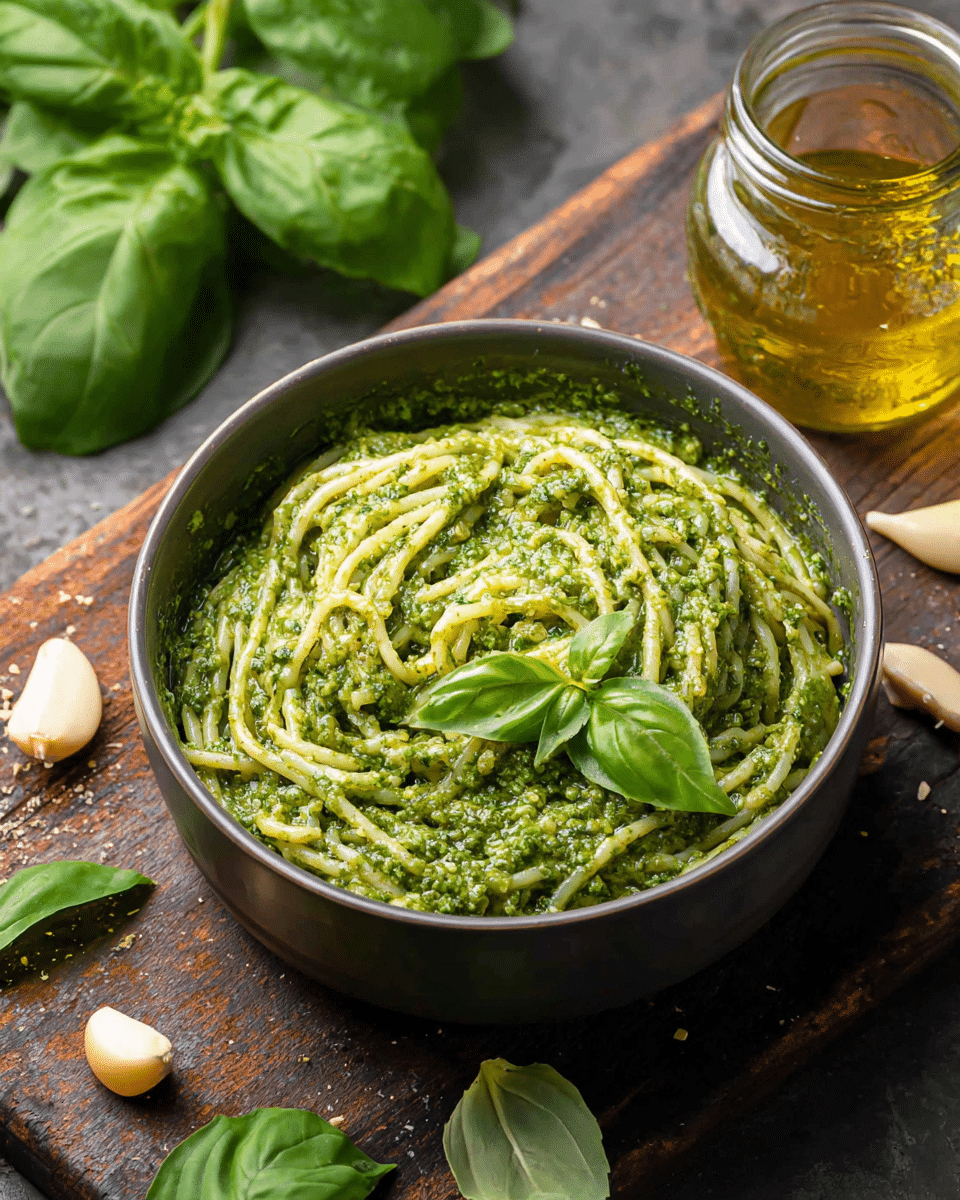Pesto alla Genovese is a timeless Italian classic that combines fresh basil, garlic, and pine nuts with rich, savory cheeses, creating a luscious sauce that will take your dishes to the next level. Whether served over pasta, spread on bread, or as a dip, it’s incredibly versatile and brings the essence of Italy into any meal.
The vibrant green color of the pesto is as beautiful as it is flavorful. This dish can be prepared in just minutes and brings out the best of fresh, seasonal ingredients. The balance of herbs and nuts gives the pesto a delightful texture and depth of flavor that complements a wide variety of dishes, from pasta to grilled vegetables and beyond.
Full recipe:
Ingredients:
-
2 cups fresh basil leaves
-
1/2 cup pine nuts
-
2 cloves garlic, minced
-
1/2 cup grated Parmesan cheese
-
1/4 cup grated Pecorino Romano cheese
-
1 cup extra virgin olive oil
-
Salt to taste
-
Freshly ground black pepper to taste
Directions:
-
In a food processor, combine basil, pine nuts, and garlic. Pulse until finely chopped.
-
Add the Parmesan, Pecorino Romano, and a pinch of salt, and pulse again to combine.
-
With the processor running, slowly drizzle in the olive oil until the pesto is smooth and well combined.
-
Taste and adjust seasoning with more salt and pepper, if desired.
-
Serve immediately over pasta, or store in an airtight container for up to a week.
Prep Time: 10 minutes | Total Time: 10 minutes | Kcal: 150 kcal | Servings: 4 servings
The Ingredients of Pesto alla Genovese
Basil is the star of pesto alla Genovese. Its fresh, slightly peppery flavor is essential in this dish, and it is recommended to use high-quality, vibrant basil leaves. Growing your own basil can enhance the flavor, but if you purchase it, look for fresh leaves that are deep green and fragrant.
Pine nuts, also known as pignoli, add a rich, slightly sweet, and buttery flavor to the pesto. These nuts are integral to the authenticity of pesto alla Genovese. While they may be a bit expensive, finding them at stores like Costco or Trader Joe’s can offer a more affordable price. If pine nuts aren’t available, walnuts can be used as a substitute, though the flavor will slightly change.
Cheese is another critical component. Traditionally, Pecorino Sardo is used in pesto alla Genovese, but Pecorino Romano is a suitable alternative if needed. Alongside Pecorino, Parmigiano Reggiano adds a nutty, savory depth to the sauce, creating the perfect creamy texture when combined with olive oil.
Olive oil should be of the highest quality. Since pesto isn’t cooked, the olive oil will play a significant role in the overall taste. A good extra virgin olive oil will bring a rich, fruity flavor that complements the fresh basil and enhances the dish’s richness.
The Traditional Method: Mortar and Pestle vs. Food Processor
While modern food processors make pesto a breeze to prepare, the traditional method of using a mortar and pestle is the authentic way to make pesto alla Genovese. The act of crushing the ingredients by hand releases oils and flavors that are sometimes muted when using machines. If you choose to follow the traditional method, be sure to have a large mortar to accommodate all the ingredients, or you may need to work in batches, adding basil leaves a little at a time.
Alternatively, if you’re in a rush, a food processor will do the job just as well. Simply pulse the ingredients until you achieve a rough paste and then adjust the consistency by adding olive oil as needed. Although the texture may differ slightly, the flavor remains largely the same.
Why Pesto alla Genovese is a Must-Try
The appeal of pesto alla Genovese lies not only in its simple, fresh ingredients but also in its versatility. While the classic pairing is pasta, pesto is excellent with gnocchi, as a topping for grilled vegetables, or even drizzled over a caprese salad with fresh mozzarella and tomatoes. The sauce can be used in a variety of dishes, both hot and cold. For example, you can spread it on sandwiches or serve it as a dip for crusty bread and raw vegetables.
Pesto also works wonderfully in salads, particularly chicken pesto pasta salad, which can be served chilled or at room temperature. Its bold, aromatic flavors make it a perfect addition to any gathering or meal, whether it’s a casual lunch or an elegant dinner.
Tips for Making the Best Pesto alla Genovese
There are a few tips to ensure your pesto alla Genovese is as delicious as possible:
-
Use Fresh Ingredients: Since pesto relies on fresh basil, make sure to select the freshest herbs you can find. If you can, grow your own basil for the best flavor.
-
Don’t Cook It: The beauty of pesto is that it’s raw. Cooking it would alter the fresh, vibrant flavors, so it’s essential to avoid any heat while preparing it.
-
Make Ahead for Better Flavor: Pesto tastes even better the next day. Allow it to sit in the fridge overnight to let the flavors meld and intensify. If you want to prepare it in advance, pesto can also be frozen for up to six months. Store it in Ziploc bags or ice cube trays for easy portioning.
-
Adjust Consistency: Depending on how thick or thin you like your pesto, you can adjust the consistency by adding more olive oil or reserved pasta water when mixing with pasta. The latter helps to emulsify the sauce and give it a creamy texture that coats the pasta perfectly.
Conclusion
Pesto alla Genovese is a timeless, versatile sauce that can enhance many dishes, whether you’re making a classic pasta, topping a salad, or preparing a grilled meal. Its simplicity is a testament to the genius of Italian cooking, where a few fresh, high-quality ingredients combine to create a flavorful masterpiece. With its fresh basil, rich cheese, and fragrant olive oil, pesto alla Genovese is more than just a sauce – it’s a celebration of the ingredients of the Ligurian region.
Whether you make it traditionally with a mortar and pestle or take a shortcut with a food processor, pesto alla Genovese remains a delicious, easy-to-make dish that captures the essence of Italian cuisine. With endless possibilities for use, this sauce will undoubtedly become a staple in your culinary repertoire, perfect for all seasons.






